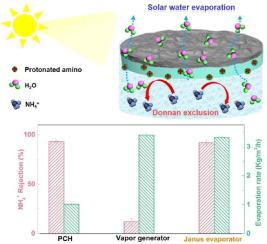Chemical Engineering Journal ( IF 15.1 ) Pub Date : 2021-10-19 , DOI: 10.1016/j.cej.2021.133019 Qingbo Xiao 1, 2 , Yan Zhu 1 , Yonglan Xi 1, 2 , Xiangping Kong 1, 2 , Xiaomei Ye 1, 2 , Zhiyang Zhang 1, 2 , Cunpu Qiu 1, 2 , Wenlong Xu 1, 2 , Shuang Cheng 3 , Jing Zhang 4 , Mingli Jia 5 , Enhui Sun 1 , Hongzhen Lin 3 , Jian Wang 3, 6

|
Developing solar-driven photothermal materials with superior rejection capability toward volatile ammonium (NH4+) is a huge challenge but rather important for agricultural/municipal wastewater remediation. Herein, different from common hierarchical porosity designs, a positive charge-assisted Janus hydrogel evaporator with enhanced Donnan exclusion toward ammonium is uniquely achieved without sacrificing the water evaporation capability. The ammonium diffusion resistance of the so-fabricated Janus evaporator is significantly increased by optimizing the charge density and diffusion distance, yielding a high ammonium rejection rate up to 95%, which is never reported before. Meanwhile, the Janus evaporator also yields a water evaporation rate up to 3.3 kg m−2h−1 for the natural wastewater via partial amorphization of cellulose Iα allomorph, which is ∼3 times faster than the previous photothermal materials for intercepting volatile phenol molecules. This work points out new avenues for the application of photothermal materials in separating freshwater from small volatile molecules using clean solar energy.
中文翻译:

高电荷水凝胶对铵具有增强的唐南排斥,用于高效的太阳能驱动水修复
开发对挥发性铵 (NH 4 + )具有优异抑制能力的太阳能驱动光热材料是一项巨大的挑战,但对于农业/市政废水修复而言却相当重要。在此,与常见的分级孔隙率设计不同,在不牺牲水蒸发能力的情况下,独特地实现了具有增强的唐南对铵的排斥的正电荷辅助 Janus 水凝胶蒸发器。通过优化电荷密度和扩散距离,如此制造的 Janus 蒸发器的铵扩散阻力显着增加,产生高达 95% 的高铵去除率,这是以前从未报道过的。同时,Janus 蒸发器也产生高达 3.3 kg m -2 h -1的水蒸发率通过纤维素 Iα 异形体的部分非晶化处理天然废水,这比以前用于拦截挥发性酚分子的光热材料快约 3 倍。这项工作指出了应用光热材料利用清洁太阳能将淡水与挥发性小分子分离的新途径。


























 京公网安备 11010802027423号
京公网安备 11010802027423号